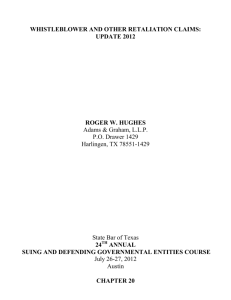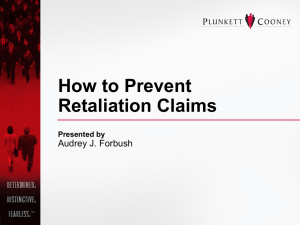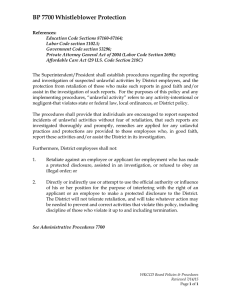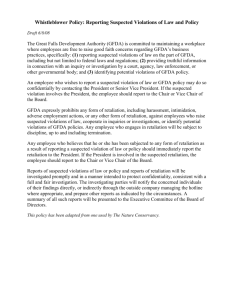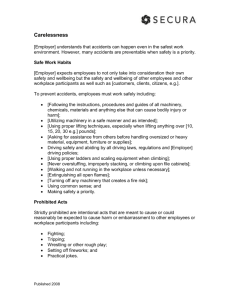Commentary Employment Practices Liability Coverage For Retaliation Claims
advertisement
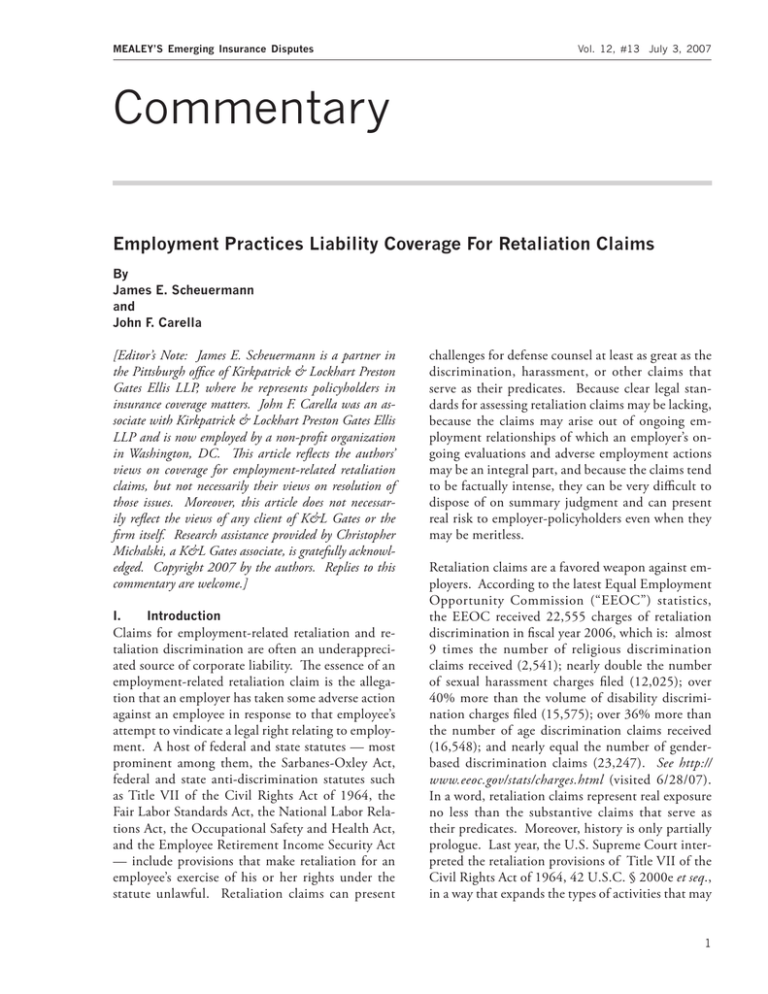
MEALEY’S Emerging Insurance Disputes Vol. 12, #13 July 3, 2007 Commentary Employment Practices Liability Coverage For Retaliation Claims By James E. Scheuermann and John F. Carella [Editor’s Note: James E. Scheuermann is a partner in the Pittsburgh office of Kirkpatrick & Lockhart Preston Gates Ellis LLP, where he represents policyholders in insurance coverage matters. John F. Carella was an associate with Kirkpatrick & Lockhart Preston Gates Ellis LLP and is now employed by a non-profit organization in Washington, DC. This article reflects the authors’ views on coverage for employment-related retaliation claims, but not necessarily their views on resolution of those issues. Moreover, this article does not necessarily reflect the views of any client of K&L Gates or the firm itself. Research assistance provided by Christopher Michalski, a K&L Gates associate, is gratefully acknowledged. Copyright 2007 by the authors. Replies to this commentary are welcome.] I. Introduction Claims for employment-related retaliation and retaliation discrimination are often an underappreciated source of corporate liability. The essence of an employment-related retaliation claim is the allegation that an employer has taken some adverse action against an employee in response to that employee’s attempt to vindicate a legal right relating to employment. A host of federal and state statutes — most prominent among them, the Sarbanes-Oxley Act, federal and state anti-discrimination statutes such as Title VII of the Civil Rights Act of 1964, the Fair Labor Standards Act, the National Labor Relations Act, the Occupational Safety and Health Act, and the Employee Retirement Income Security Act — include provisions that make retaliation for an employee’s exercise of his or her rights under the statute unlawful. Retaliation claims can present challenges for defense counsel at least as great as the discrimination, harassment, or other claims that serve as their predicates. Because clear legal standards for assessing retaliation claims may be lacking, because the claims may arise out of ongoing employment relationships of which an employer’s ongoing evaluations and adverse employment actions may be an integral part, and because the claims tend to be factually intense, they can be very difficult to dispose of on summary judgment and can present real risk to employer-policyholders even when they may be meritless. Retaliation claims are a favored weapon against employers. According to the latest Equal Employment Opportunity Commission (“EEOC”) statistics, the EEOC received 22,555 charges of retaliation discrimination in fiscal year 2006, which is: almost 9 times the number of religious discrimination claims received (2,541); nearly double the number of sexual harassment charges filed (12,025); over 40% more than the volume of disability discrimination charges filed (15,575); over 36% more than the number of age discrimination claims received (16,548); and nearly equal the number of genderbased discrimination claims (23,247). See http:// www.eeoc.gov/stats/charges.html (visited 6/28/07). In a word, retaliation claims represent real exposure no less than the substantive claims that serve as their predicates. Moreover, history is only partially prologue. Last year, the U.S. Supreme Court interpreted the retaliation provisions of Title VII of the Civil Rights Act of 1964, 42 U.S.C. § 2000e et seq., in a way that expands the types of activities that may MEALEY’S Emerging Insurance Disputes Vol. 12, #13 July 3, 2007 give rise to an actionable retaliation claim. This decision will inevitably lead to a greater number of retaliation claims and greater employer exposure for such claims. Against the backdrop of this inhospitable risk landscape, it is all the more important that corporate policyholders understand and utilize their available insurance coverage for retaliation claims. Specifically, Employment Practices Liability (“EPL”) insurance policies, which have been broadly marketed since the early 1990s, often expressly provide defense and indemnity coverage for retaliation claims. See, e.g., San Miguel v. Necso Redondo, S.E., 394 F. Supp.2d 416 (D. PR 2005); see also Township of Bridgewater v. Diamond State Ins. Co., 2005 WL 4123417 (N.J. Super. App. Div. June 20, 2006) (public officials liability policy providing EPL coverage). II. EPL Policies There is no single, industry-wide standard EPL policy form. Nonetheless, typically EPL policies cover a host of workplace- and employment-related claims, including wrongful discipline, wrongful termination, failure to promote, wrongful demotion, harassment, discrimination, deprivation of a career opportunity, other violations of employment laws, and breach of contract. Some EPL policies expressly identify retaliation as a covered act while others do not. Depending on the context, any of these other types of covered actions may constitute a form of retaliation, and thus be within the policy’s coverage. See, e.g., Missouri Pub. Entity Risk Mgt. Fund v. Investors Ins. Co. of Am., 338 F. Supp.2d 1046, 1052 (W.D. Mo. 2004). Exclusions in EPL policies purport to carve out areas of employment-related liability and remove them from the coverage provided by the policy. Of particular interest here, EPL exclusions may attempt to bar coverage for violations of: • the Fair Labor Standards Act (“FLSA”); • the National Labor Relations Act (“NLRA”); • federal and state securities laws, including the Sarbanes-Oxley Act; • the Occupational Safety and Health Act (“OSHA”); and • the Employee Retirement Income Security Act (“ERISA”). Each of these exclusions, however, also commonly contains an exception to the exclusion that preserves coverage for claims for “retaliation” or “retaliatory treatment,” even in those policies that do not expressly identify retaliation as a covered act. For example, the standard form EPL policy promulgated by ISO Properties, Inc., provides that the exclusion for the violation of laws applicable to employers: does not apply to any “claim” for retaliatory treatment by an insured against any person making a “claim” pursuant to such person’s rights under any statutes, rules or regulations. See 1 Miller’s Standard Insurance Policies Annotated at p. 411.6 (4th ed. 2006) (ISO form EP00 01 01 02). More specifically, one such exception to an NLRA exclusion provides: [T]his Exclusion shall not apply to any Claim for retaliatory treatment of any claimant(s) because of claimant’s actual or alleged exercise of a right protected under the NLRA or related statutes, or any law, statute or regulation similar to the foregoing. See, e.g., XL Insurance (Bermuda) LTD, Form EPL005, as amended by AON Amendatory Endorsement EP319.02. Thus, while an alleged violation of the NLRA may be excluded under an EPL policy, a plaintiff’s follow-on claim of retaliation for attempting to exercise his or her rights under the NLRA would not be excluded and would be within the policy’s coverage. The exceptions to the FLSA, securities laws, OSHA, and ERISA exclusions typically are similarly worded and the same analysis applies to them. See, e.g., Federal Insurance Company, EPLI Form 14-02-0953 (Rev. 8/96) (“this exclusion shall not apply to any Claim for retaliatory treatment of any claimant because of any claimant’s actual or alleged protected lawful activity under” the FLSA or OSHA). In order to understand what coverage is preserved though the retaliation exceptions to these exclusions, a few words on the current status of the law on retaliation is helpful. MEALEY’S Emerging Insurance Disputes III. The Burlington Northern Decision And The Sarbanes-Oxley Act A. The Burlington Northern Decision The Supreme Court recently expanded the scope of employer conduct that can give rise to a viable retaliation claim under Title VII of the Civil Rights Act of 1964 in Burlington Northern & Santa Fe Rwy. Co. v. White. __ U.S. __, 126 S.Ct. 2405 (2006). Title VII’s anti-retaliation provision prohibits an employer from “discriminat[ing] against” an employee or job applicant because that individual “opposed any practices” made unlawful by Title VII or “made a charge, testified, assisted, or participated in” a Title VII proceeding, hearing, or investigation. 42 U.S.C. § 2000e-3(a). Prior to the Court’s decision in Burlington Northern, many federal circuit courts held that a retaliation claim could be maintained under Title VII only if the alleged retaliatory action affected the terms and conditions of employment or constituted an “ultimate employment decision” such as termination, hiring, or promotion. See, e.g., Mattern v. Eastman Kodak Co., 104 F.3d 702, 707 (5th Cir. 1997); Manning v. Metropolitan Life Ins. Co., 127 F.3d 686, 692 (8th Cir. 1997). Burlington Northern, however, significantly expands the rights of employees under Title VII’s anti-retaliation provision. The expansion stems from the Court’s holding that the anti-retaliation provision applies not just to employment-related actions that adversely affect the terms and conditions of employment (such as firing or demotion), but also to actions not directly impacting the employee’s terms or conditions of employment. Normal, facially non-retaliatory conduct may constitute unlawful retaliation because of the context, including factors and conduct outside the workplace. An example of this extension beyond employment cited by the Court was an employer’s filing of false criminal charges against an employee who had filed a discrimination complaint. Burlington Northern, 126 S. Ct. at 2412. A supervisor’s assault of an employee at a local tavern frequented by an employer’s work force may be another example. In articulating this standard, the Court held that a plaintiff alleging retaliation “must show that a reasonable employee would have found the challenged action materially adverse, which in this context means it well might have dissuaded a reasonable worker from making or supporting a charge of discrimination.” Id. at 2415 (internal quotes and citation omitted). The Vol. 12, #13 July 3, 2007 Court emphasized the distinction between “significant” and “trivial” harms when it chose the “materially adverse” language. It noted that Title VII does not prevent an employee complaining of employer discrimination from experiencing “petty slights or minor annoyances that often take place at work and that all employees experience,” id., since these do not normally deter employees from reporting discrimination or participating in complaints. Burlington Northern’s rationale may well be extended by the courts to retaliation claims under other statutes, such as the Americans with Disabilities Act, the Age Discrimination in Employment Act, the Equal Pay Act, and the many other federal statutes that use anti-retaliation language similar to that of Title VII. In the course of its discussion in Burlington Northern, the Court drew an analogy between the anti-retaliation provision of Title VII and that of the NLRA, which the Court had previously interpreted with similar breadth. See, id. at 2414; Bill Johnson’s Restaurants, Inc. v. NLRB, 461 U.S. 731, 740 (1983) (finding the Court’s liberal construction of anti-retaliation provisions such as the NLRA’s to prohibit “a wide variety of employer conduct that is intended to restrain, or that has the likely effect of restraining, employees in the exercise of protected activities.”). The clear implication is that the Burlington Northern holding will reverberate well beyond Title VII, and so employers’ exposure will be expanded accordingly. B. The Sarbanes-Oxley Act Most discussions of the insurance implications of the statute commonly referred to as the Sarbanes-Oxley Act of 2002 (“SOX”)1 focus on coverage issues under Directors & Officers policies. The coverage implications of the anti-retaliation provisions of SOX under EPL policies are worth careful attention as well. Section 806 of SOX, codified at 18 U.S.C. § 1514A, creates a new federal civil private cause of action for employees of public companies who have been retaliated against because of any “lawful act” done to provide information to the government or to assist in a proceeding filed or about to be filed relating to, inter alia, fraud against shareholders or violations of Securities and Exchange Commission rules or regulations. Specifically, Section 806 provides that no public company or their officers, employees, contractors, subcontractors, and agents “may discharge, demote, MEALEY’S Emerging Insurance Disputes Vol. 12, #13 July 3, 2007 suspend, threaten, harass, or in any manner discriminate against an employee in the terms and conditions of employment because of any lawful act done by the employee . . .” with respect to disclosing corporate securities fraud and other related wrongs. Remedies for violations of Section 806 include compensatory damages, back pay, attorneys’ fees and costs.2 SOX retaliation claims must first proceed in a fasttrack administrative proceeding and then may be filed in federal court for a de novo review. An adequate defense of such claims may involve both employment lawyers and securities lawyers. For these reasons, and others mentioned at the outset of this article, SOX retaliation claims are likely to be costly to defend. Accordingly, the defense coverage available under EPL policies for a retaliation claim asserted under SOX may be of significant value even if the claim proves meritless and indemnification coverage is not forthcoming. IV. Protecting Insurance Coverage For Claims Of Employment-Related Retaliation In light of the Burlington Northern decision, the anti-retaliation provisions of SOX, and the pervasiveness of retaliation claims, policyholders may find it of some benefit to review all of their employmentrelated claims and their EPL policies to determine if claims of retaliation have been made for which coverage may be available. Such analysis may suggest a clear path to retaliation coverage. Consider, for example, a not uncommon National Labor Relations Board (“NLRB”) charge that an employer threatened to terminate an employee who had filed an earlier NLRB charge, or that an employer fired an employee because the employee assisted union supporters by testifying before the NLRB. Under the anti-retaliation provision of the NLRA (which prohibits employers from “discharg[ing] or otherwise discriminat[ing] against an employee” who has filed charges or given testimony relating to a substantive NLRA violation, 29 U.S.C. § 158(a)(4)) and any commonly understood meaning of “retaliation,” these activities would be prima facie forms of retaliation for which EPL coverage is expressly preserved in common exceptions to the NLRA exclusion. In addition, policyholders often find it prudent to take the following steps to preserve coverage for em ployment-related retaliation claims, including SOX retaliation claims: • provide prompt notice to the insurer of written demands for legal redress, administrative proceedings, and complaints filed in court (this is particularly important when a policy is written on a “claims-made” basis, as virtually all EPL policies are); • take immediate steps to preserve documents that may be related to the claim, particularly the claimant’s personnel file and electronic documents that may otherwise be recoverable only with great difficulty and expense; • collect all potentially relevant EPL (and other potentially implicated) policies and have those policies reviewed by coverage counsel; and • seek advice from coverage counsel on the conduct of the defense of the underlying claim from an insurance coverage perspective, and have coverage counsel and defense counsel cooperate in their efforts. These initial steps may go a long way toward protecting a policyholder’s EPL coverage for retaliation claims. V. Conclusion Like revenge, retaliation is often its own punishment. This is especially true in today’s legal environment, when numerous federal and state statutes give employees substantial rights to redress for an employer’s retaliation. Fortunately, corporate policyholders may obtain defense or indemnity coverage for retaliation claims under their EPL policies even when the principal claim is otherwise excluded from coverage. Accordingly, when assessing insurance coverage for an employment-related claim, employers, risk managers, and counsel may find it beneficial to pay particular attention to coverage for any associated retaliation claims. The anti-retaliation provisions of SOX and the United States Supreme Court’s recent expansion of employees’ rights to assert actionable retaliation claims suggests that the number of such claims will increase and that these claims may play an increasingly important role in insurance coverage disputes under EPL policies. MEALEY’S Emerging Insurance Disputes Endnotes 1. The formal title of the act is The Public Company Accounting Reform and Investor Protection Act of 2002. Pub. L. 107-204, 116 Stat. 745 (2002). 2. Section 1107 of SOX creates a new criminal cause of action for knowing and intentional retaliation against any person who provides any truthful information relating to the commission or possible commission “of any Federal offense.” There Vol. 12, #13 July 3, 2007 may be EPL coverage for SOX criminal retaliation claims, depending on whether the policy in question excludes criminal acts coverage or coverage for fines and penalties and whether under applicable law the carrier may indemnify an insured for proven criminal acts. Even if indemnity coverage is not available for a Section 1107 violation, the insured may be able to obtain defense coverage or the periodic reimbursement of defense expenses, depending on the language of the EPL policy’s defense provisions. n


